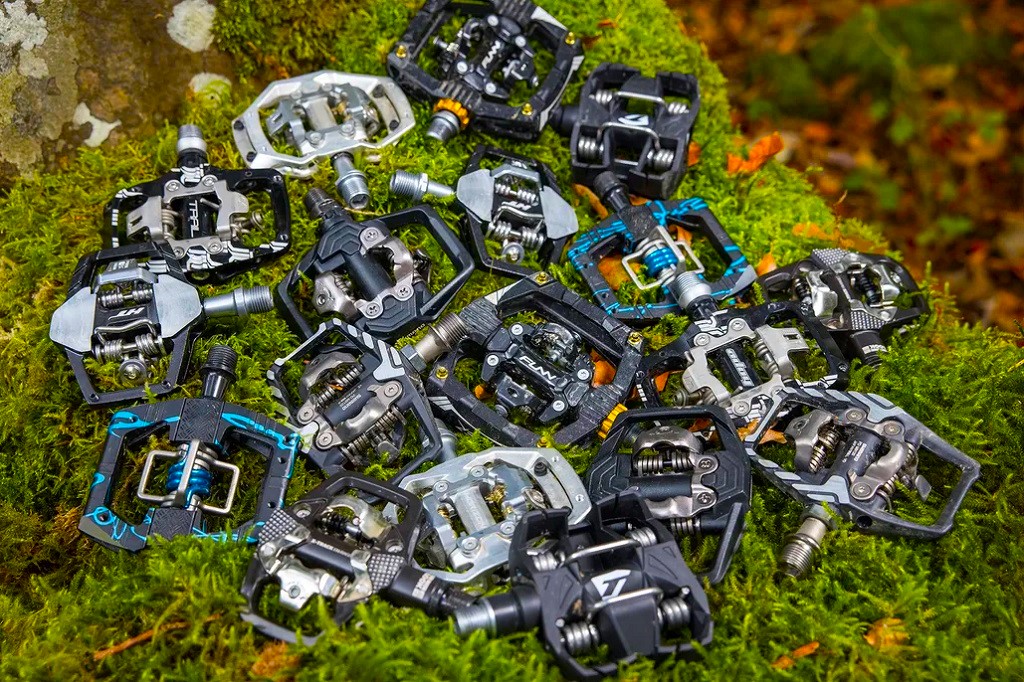Selecting the right pedals for your mountain bike (MTB) can significantly enhance your riding experience. Whether you’re a beginner navigating flowy trails or a seasoned veteran shredding technical terrain, your pedals are integral to maintaining control and power transfer. The two main categories of mountain bike pedals – flats and clipless – each offer distinct advantages and should be chosen based on your riding style and preferences.
Flat Pedals: The Choice for Freedom and Flexibility
Flat pedals, also known as platform pedals, are the go-to for many downhill, freeride, and dirt jump riders. They offer these advantages:
- Ease of Use: Flat pedals are incredibly user-friendly, requiring no special cleats or shoes. Simply step on and start pedaling.
- Quick Foot Placement: You can rapidly adjust your foot positioning on flat pedals, a valuable asset when tackling tricky terrain or catching air.
- Bail-Out Option: When things get sketchy, you can instantly dismount, giving you a better chance of safely getting a foot down to prevent a crash.
Modern flat pedals provide incredible grip to keep your feet firmly planted and maximize control. Here’s what to look for:
- Large Platform: A substantial platform offers better support and stability, giving you more confidence on rough trails.
- Replaceable Pins: High-quality flat pedals feature adjustable and replaceable metal pins that bite into your shoe soles for maximum grip.
- Concave Shape: Many premium flat pedals have a slightly concave design, which cradles your foot and enhances stability.
Related: How to Remove Bike Pedals Easy Way to Do
Clipless Pedals: Efficiency and Power on Tap
Clipless pedals, though slightly misleading in name, are designed to securely connect your cycling shoes to the pedal via a cleat mechanism. They offer significant benefits:
- Power Transfer: The locked-in connection between the shoe and pedal allows you to pull up on your pedals as well as push down, translating to greater pedaling efficiency, particularly on climbs.
- Reduced Fatigue: Clipless pedals help recruit more leg muscles during the pedal stroke, reducing fatigue over longer rides.
- Technical Terrain Control: Being securely attached to your pedals enhances bike control in rough sections, giving you more confidence.
While clipless pedals necessitate the use of specific cycling shoes with compatible cleats, the performance gains make them incredibly popular for cross-country, trail, and enduro riders. Consider the following:
- Release Tension: Most clipless pedals feature adjustable release tension, allowing you to fine-tune how much force is needed to unclip. Beginners should opt for lower tension for easy exits.
- Float: Float refers to the amount of lateral rotation your foot has while clipped in. More float can reduce strain on your knees.
- Platform Size: Some clipless pedals have a small platform or cage around the mechanism, providing extra support when you’re temporarily unclipped.
Hybrid Pedals: The Best of Both Worlds
If you can’t quite decide, hybrid pedals offer a versatile solution. These pedals feature a flat platform on one side and a clipless mechanism on the other. This lets you ride clipped in when you want efficiency and power, or switch to the flat side for technical sections or when practicing skills.
Beyond the Basics: Finding Your Perfect Pedals
Ultimately, the best pedals for you depend on your personal needs and riding style:
- Skill Level: Beginners might find the ease of use and bail-out potential offered by flat pedals more comfortable while learning.
- Discipline: Consider the demands of your chosen discipline. Downhill and dirt jumpers often go for flats, while cross-country racers prioritize clipless.
- Personal Preference: Above all, trust your gut feeling. Try different options if possible and choose pedals that make you feel secure, comfortable, and confident.
Remember: High-quality pedals from trusted brands are essential for ensuring durability and reliability on the trails. Consider factors like platform size, pin configuration, cleat style, and overall build quality before making your decision. With the right pedals, you’ll be ready to conquer any mountain biking adventure that comes your way!

Taylor is an outdoors & sports equipment specialist, sports author, bike traveler, bicycling and skating expert, and smoke-free ride activist. He is also a regular reviewer of outdoor sports gadgets and accessories. About safety gear and biking facts he analyzes and gives his feedback to outdoorxsports. Writes and tests to help him, you, and us.

